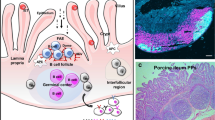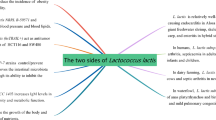Abstract
Lactobacillus strains have been considered good candidates as biological control agents for prevention or treatment of plant and animal infections. One L. plantarum strain FB003 and three strains (FB011, FB081, and FB110) which closed to L. sakei were isolated from fermented and salted shrimp and their abilities in inhibiting growth of Vibrio parahaemolyticus were characterized. These strains were selected as potential probiotics based on their oro-gastro-intestinal resistance, gut colonization, adhesion to Caco-2 cells, antimicrobial activities, antibiotic resistance, and safety aspects. Results of this study revealed that these isolates possessed high aggregation activities against pathogens in host intestines. Strain FB011 strain showed higher coaggregation and immunomodulatory activity in the gastro-intestinal tract than L. plantarum. These difference effects of Lactobacillus strains provide valuable information about using them to prevent Vibrio infections in the aquaculture industry.
Similar content being viewed by others
References
Angmo, K., Kumari, A., and Bhalla, T.C. 2016. Probiotic characterization of lactic acid bacteria isolated from fermented foods and beverage of Ladakh. LWT-Food Sci.Technol. 66, 428–435.
Anyogu, A., Awamaria, B., Sutherland, J., and Ouoba, L. 2014. Molecular characterisation and antimicrobial activity of bacteria associated with submerged lactic acid cassava fermentation. Food Control 39, 119–127.
Baker-Austin, C., Trinanes, J.A., Taylor, N.G., Hartnell, R., Siitonen, A., and Martinez-Urtaza, J. 2013. Emerging Vibrio risk at high latitudes in response to ocean warming. Nat. Clim. Chang 3, 73.
Bove, P., Gallone, A., Russo, P., Capozzi, V., Albenzio, M., Spano, G., and Fiocco, D. 2012. Probiotic features of Lactobacillus plantarum mutant strains. Appl. Microbiol. Biotechnol. 96, 431–441.
Bove, P., Russo, P., Capozzi, V., Gallone, A., Spano, G., and Fiocco, D. 2013. Lactobacillus plantarum passage through an oro-gastro- intestinal tract simulator: carrier matrix effect and transcriptional analysis of genes associated to stress and probiosis. Microbiol. Res. 168, 351–359.
Bover-Cid, S. and Holzapfel, W.H. 1999. Improved screening procedure for biogenic amine production by lactic acid bacteria. Int. J. Food Microbiol. 53, 33–41.
Collado, M.C., Meriluoto, J., and Salminen, S. 2008. Adhesion and aggregation properties of probiotic and pathogen strains. Eur. Food Res. Technol. 226, 1065–1073.
Corr, S.C., Li, Y., Riedel, C.U., O’Toole, P.W., Hill, C., and Gahan, C.G. 2007. Bacteriocin production as a mechanism for the antiinfective activity of Lactobacillus salivarius UCC118. Proc. Natl. Acad. Sci. USA 104, 7617–7621.
Damodharan, K., Palaniyandi, S.A., Yang, S.H., and Suh, J.W. 2015. In vitro probiotic characterization of Lactobacillus strains from fermented radish and their anti-adherence activity against enteric pathogens. Can. J. Microbiol. 61, 837–850.
De Vries, M.C., Vaughan, E.E., Kleerebezem, M., and de Vos, W.M. 2006. Lactobacillus plantarum–survival, functional and potential probiotic properties in the human intestinal tract. Int. Dairy J. 16, 1018–1028.
Eaton, T.J. and Gasson, M.J. 2001. Molecular screening of Enterococcusvirulence determinants and potential for genetic exchange between food and medical isolates. Appl. Environ. Microbiol. 67, 1628–1635.
Galdeano, C.M. and Perdigon, G. 2004. Role of viability of probiotic strains in their persistence in the gut and in mucosal immune stimulation. J. Appl. Microbiol. 97, 673–681.
García-Cayuela, T., Korany, A.M., Bustos, I., de Cadiñanos, L.P.G., Requena, T., Peláez, C., and Martínez-Cuesta, M.C. 2014. Adhesion abilities of dairy Lactobacillus plantarum strains showing an aggregation phenotype. Food Res. Int. 57, 44–50.
García-Ruiz, A., de Llano, D.G., Esteban-Fernández, A., Requena, T., Bartolomé, B., and Moreno-Arribas, M.V. 2014. Assessment of probiotic properties in lactic acid bacteria isolated from wine. Food Microbiol. 44, 220–225.
Gareau, M.G., Sherman, P.M., and Walker, W.A. 2010. Probiotics and the gut microbiota in intestinal health and disease. Nat. Rev. Gastroenterol. Hepatol. 7, 503–514.
Gerez, C.L., Torres, M.J., De Valdez, G.F., and Rollán, G. 2013. Control of spoilage fungi by lactic acid bacteria. Biol. Control 64, 231–237.
Gomez-Gil, B., Soto-Rodriguez, S., Garcia-Gasca, A., Roque, A., Vazquez-Juarez, R., Thompson, F.L., and Swings, J. 2004. Molecular identification of Vibrio harveyi-related isolates associated with diseased aquatic organisms. Microbiology 150, 1769–1777.
Holmström, K., Gräslund, S., Wahlström, A., Poungshompoo, S., Bengtsson, B.E., and Kautsky, N. 2003. Antibiotic use in shrimp farming and implications for environmental impacts and human health. Int. J. Food Sci. Technol. 38, 255–266.
Hsiao, A., Ahmed, A.S., Subramanian, S., Griffin, N.W., Drewry, L.L., Petri, W.A. Jr., Haque, R., Ahmed, T., and Gordon, J.I. 2014. Members of the human gut microbiota involved in recovery from Vibrio cholerae infection. Nature 515, 423.
Joshi, J., Srisala, J., Truong, V.H., Chen, I.T., Nuangsaeng, B., Suthienkul, O., Lo, C.F., Flegel, T.W., Sritunyalucksana, K., and Thitamadee, S. 2014. Variation in Vibrio parahaemolyticus isolates from a single Thai shrimp farm experiencing an outbreak of acute hepatopancreatic necrosis disease (AHPND). Aquaculture 428, 297–302.
Le, T.X. and Munekage, Y. 2004. Residues of selected antibiotics in water and mud from shrimp ponds in mangrove areas in Viet Nam. Mar. Pollut. Bull. 49, 922–929.
Lee, H., Yoon, H., Ji, Y., Kim, H., Park, H., Lee, J., Shin, H., and Holzapfel, W. 2011. Functional properties of Lactobacillus strains isolated from kimchi. Int. J. Food Microbiol. 145, 155–161.
Li, P., Gu, Q., and Zhou, Q. 2016. Complete genome sequence of Lactobacillus plantarum LZ206, a potential probiotic strain with antimicrobial activity against food-borne pathogenic microorganisms. J. Biotechnol. 238, 52–55.
Marteau, P., Minekus, M., Havenaar, R., and Huis, J. 1997. Survival of lactic acid bacteria in a dynamic model of the stomach and small intestine: validation and the effects of bile. J. Dairy Sci. 80, 1031–1037.
Murry Jr, A., Hinton Jr, A., and Morrison, H. 2004. Inhibition of growth of Escherichia coli, Salmonella typhimurium, and Clostridia perfringens on chicken feed media by Lactobacillus salivarius and Lactobacillus plantarum. Int. J. Poult. Sci. 3, 603–607.
Naidu, A.S., Bidlack, W.R., and Clemens, R.A. 1999. Probiotic spectra of lactic acid bacteria (LAB). Crit. Rev. Food Sci. Nutr. 39, 13–126.
Panel, E.F. 2012. Guidance on the assessment of bacterial susceptibility to antimicrobials of human and veterinary importance. EFSA J. 10, 2740.
Qi, Z., Zhang, X.H., Boon, N., and Bossier, P. 2009. Probiotics in aquaculture of China–current state, problems and prospect. Aquaculture 290, 15–21.
Roselló, G., Bonaterra, A., Francés, J., Montesinos, L., Badosa, E., and Montesinos, E. 2013. Biological control of fire blight of apple and pear with antagonistic Lactobacillus plantarum. Eur. J. Plant Pathol. 137, 621–633.
Saarela, M., Mogensen, G., Fonden, R., Mättö, J., and Mattila-Sandholm, T. 2000. Probiotic bacteria: safety, functional and technological properties. J. Biotechnol. 84, 197–215.
Satish Kumar, R., Kanmani, P., Yuvaraj, N., Paari, K., Pattukumar, V., and Arul, V. 2011. Lactobacillus plantarum AS1 binds to cultured human intestinal cell line HT-29 and inhibits cell attachment by enterovirulent bacterium Vibrio parahaemolyticus. Lett. Appl. Microbiol. 53, 481–487.
Saxami, G., Karapetsas, A., Lamprianidou, E., Kotsianidis, I., Chlichlia, A., Tassou, C., Zoumpourlis, V., and Galanis, A. 2016. Two potential probiotic lactobacillus strains isolated from olive microbiota exhibit adhesion and anti-proliferative effects in cancer cell lines. J. Funct. Foods 24, 461–471.
Vezzulli, L., Grande, C., Reid, P.C., Hélaouët, P., Edwards, M., Höfle, M.G., Brettar, I., Colwell, R.R., and Pruzzo, C. 2016. Climate influence on Vibrio and associated human diseases during the past half-century in the coastal North Atlantic. Proc. Natl. Acad. Sci.USA 113, E5062–E5071.
Wiegand, I., Hilpert, K., and Hancock, R.E. 2008. Agar and broth dilution methods to determine the minimal inhibitory concentration (MIC) of antimicrobial substances. Nat. Protoc. 3, 163.
Wu, Y., Wen, J., Ma, Y., Ma, X., and Chen, Y. 2014. Epidemiology of foodborne disease outbreaks caused by Vibrio parahaemolyticus, China, 2003–2008. Food Control 46, 197–202.
Xu, H., Jeong, H., Lee, H., and Ahn, J. 2009. Assessment of cell surface properties and adhesion potential of selected probiotic strains. Lett. Appl. Microbiol. 49, 434–442.
Zhou, J.S., Gopal, P.K., and Gill, H.S. 2001. Potential probiotic lactic acid bacteria Lactobacillus rhamnosus (HN001), Lactobacillus acidophilus (HN017) and Bifidobacterium lactis (HN019) do not degrade gastric mucin in vitro. Int. J. Food Microbiol. 63, 81–90.
Author information
Authors and Affiliations
Corresponding author
Additional information
Supplemental material for this article may be found at http://www.springerlink.com/content/120956.
Electronic supplementary material
Rights and permissions
About this article
Cite this article
Le, B., Yang, S.H. Probiotic potential of novel Lactobacillus strains isolated from salted-fermented shrimp as antagonists for Vibrio parahaemolyticus. J Microbiol. 56, 138–144 (2018). https://doi.org/10.1007/s12275-018-7407-x
Received:
Revised:
Accepted:
Published:
Issue Date:
DOI: https://doi.org/10.1007/s12275-018-7407-x




